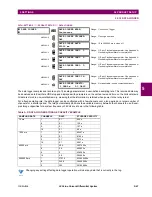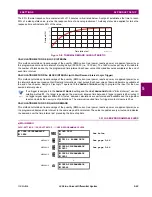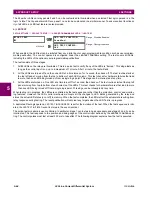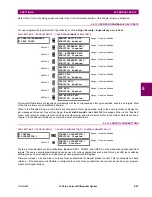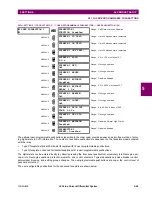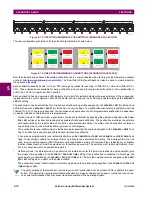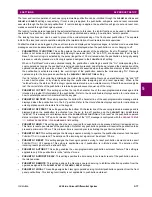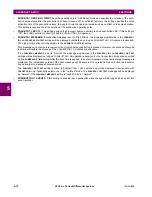
GE Multilin
L90 Line Current Differential System
5-57
5 SETTINGS
5.2 PRODUCT SETUP
5
During communication channel failures, the L90 uses the single-ended algorithm to calculate and report fault location.
When the single-ended algorithm is used for three-terminal line applications, the faulted segment of the line is not deter-
mined and reported.
The L90 relay supports one fault report and an associated fault locator. The signal source and trigger condition, as well as
the characteristics of the line or feeder, are entered in this menu.
The fault report stores data, in non-volatile memory, pertinent to an event when triggered. The captured data contained in
the
FaultReport.txt
file includes:
•
Fault report number.
•
Name of the relay, programmed by the user.
•
Firmware revision of the relay.
•
Date and time of trigger.
•
Name of trigger (specific operand).
•
Line or feeder ID via the name of a configured signal source.
•
Active setting group at the time of trigger.
•
Pre-fault current and voltage phasors (two cycles before either a 50DD disturbance associated with fault report source
or the trigger operate). Once a disturbance is detected, pre-fault phasors hold for 3 seconds waiting for the fault report
trigger. If trigger does not occur within this time, the values are cleared to prepare for the next disturbance.
•
Fault current and voltage phasors (one cycle after the trigger).
•
Elements operated at the time of triggering.
•
Events: 9 before trigger and 7 after trigger (only available via the relay webpage).
•
Fault duration times for each breaker (created by the breaker arcing current feature).
The captured data also includes the fault type and the distance to the fault location, as well as the reclose shot number
(when applicable) To include fault duration times in the fault report, the user must enable and configure breaker arcing cur-
rent feature for each of the breakers. Fault duration is reported on a per-phase basis.
The relay allows locating faults, including ground faults, from delta-connected VTs. In this case, the missing zero-sequence
voltage is substituted either by the externally provided neutral voltage (broken delta VT) connected to the auxiliary voltage
channel of a VT bank, or by the zero-sequence voltage approximated as a voltage drop developed by the zero-sequence
current, and user-provided zero-sequence equivalent impedance of the system behind the relay.
The trigger can be any FlexLogic™ operand, but in most applications it is expected to be the same operand, usually a vir-
tual output, that is used to drive an output relay to trip a breaker. To prevent the overwriting of fault events, the disturbance
detector should not be used to trigger a fault report. A
FAULT RPT TRIG
event is automatically created when the report is
triggered.
If a number of protection elements are ORed to create a fault report trigger, the first operation of any element causing the
OR gate output to become high triggers a fault report. However, If other elements operate during the fault and the first oper-
ated element has not been reset (the OR gate output is still high), the fault report is not triggered again. Considering the
reset time of protection elements, there is very little chance that fault report can be triggered twice in this manner. As the
fault report must capture a usable amount of pre and post-fault data, it can not be triggered faster than every 20 ms.
Each fault report is stored as a file; the relay capacity is fifteen (15) files. An sixteenth (16th) trigger overwrites the oldest
file.
The EnerVista UR Setup software is required to view all captured data. The relay faceplate display can be used to view the
date and time of trigger, the fault type, the distance location of the fault, and the reclose shot number.
The
FAULT REPORT 1 SOURCE
setting selects the source for input currents and voltages and disturbance detection. For dual-
breaker applications where the line current is supplied individually from two breaker CTs, the fault locator source should
include the sum of currents from both CTs as well as the line voltage.
The
FAULT 1 REPORT TRIG
setting assigns the FlexLogic™ operand representing the protection element/elements requiring
operational fault location calculations. The distance to fault calculations are initiated by this signal. The
FAULT REPORT 1 Z1
MAG
and
FAULT REPORT 1 Z0 MAG
impedances are entered in secondary ohms.
Summary of Contents for UR Series L90
Page 652: ...A 16 L90 Line Current Differential System GE Multilin A 1 PARAMETER LISTS APPENDIX A A ...
Page 772: ...B 120 L90 Line Current Differential System GE Multilin B 4 MEMORY MAPPING APPENDIX B B ...
Page 802: ...C 30 L90 Line Current Differential System GE Multilin C 7 LOGICAL NODES APPENDIX C C ...
Page 812: ...D 10 L90 Line Current Differential System GE Multilin D 1 IEC 60870 5 104 APPENDIX D D ...
Page 824: ...E 12 L90 Line Current Differential System GE Multilin E 2 DNP POINT LISTS APPENDIX E E ...
Page 834: ...F 10 L90 Line Current Differential System GE Multilin F 3 WARRANTY APPENDIX F F ...
Page 846: ...xii L90 Line Current Differential System GE Multilin INDEX ...



















